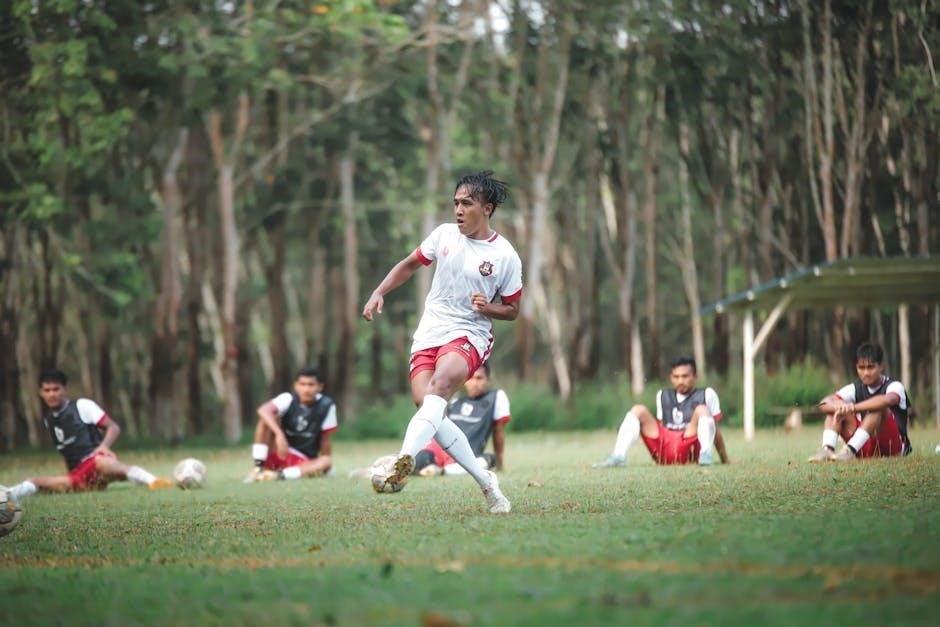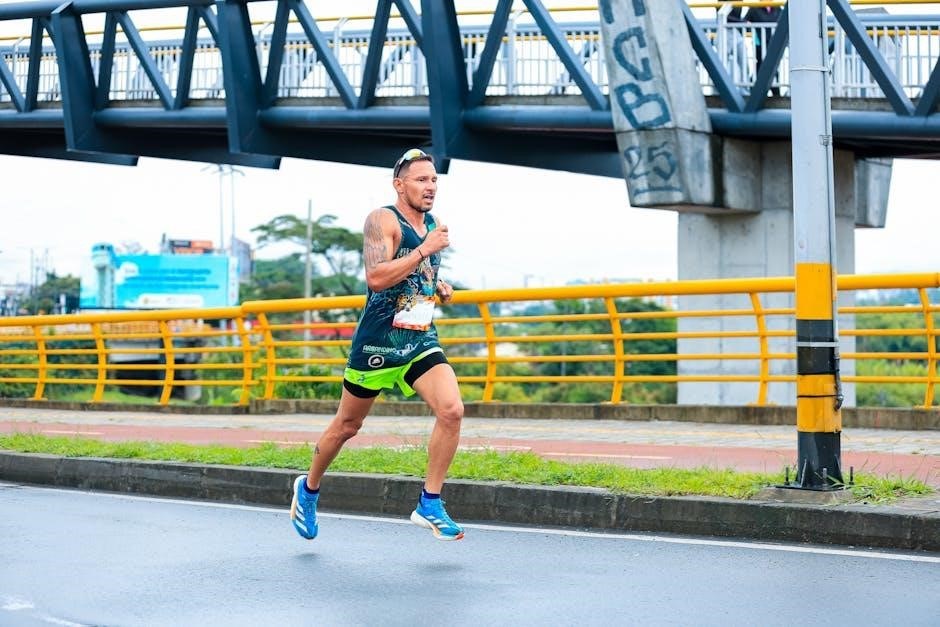The physiology of sport and exercise is a cornerstone of understanding human performance. The 8th Edition of this textbook is a leading resource, offering comprehensive insights into the science behind physical activity, exercise, and athletic performance. It covers foundational concepts, recent research, and practical applications, making it a favorite among instructors, students, and professionals in the field. This edition emphasizes the evolving nature of sport science and its impact on training, competition, and overall well-being, providing a robust framework for understanding the complexities of human physiology in motion.
1.1 Overview of the 8th Edition
The 8th Edition of Physiology of Sport and Exercise remains a leading textbook in the field, widely acclaimed for its comprehensive coverage of exercise physiology. This edition continues its legacy as a favorite among instructors and professionals, offering updated insights into the latest research and practical applications. It includes enhanced chapters on emerging topics such as sports nutrition, exercise-induced asthma, and the integration of technology in sport science. With HKPropel Access, students and researchers can engage with digital resources, question banks, and interactive tools. The PDF version is also available for easy access, making it a versatile resource for learning and reference. This edition reflects the evolving nature of sport and exercise physiology, ensuring it remains a cornerstone for education and research in the field.
1.2 Importance of Sport and Exercise Physiology
Sport and exercise physiology plays a vital role in understanding how the human body responds to physical activity. It provides insights into optimizing performance, preventing injuries, and enhancing overall health. This field is crucial for developing evidence-based training programs and informing competitive practices. By studying physiological responses, professionals can tailor strategies to improve athletic performance and promote lifelong well-being. The 8th Edition emphasizes the practical applications of this knowledge, making it indispensable for students, athletes, and healthcare professionals. Its relevance extends to addressing chronic diseases, mental health, and the integration of nutrition and technology in sport science, highlighting its broader impact on society and individual well-being.
1.3 Key Features of the 8th Edition
The 8th Edition of Physiology of Sport and Exercise stands out for its comprehensive updates and enhanced features. It includes access to HKPropel, a digital platform offering interactive resources, videos, and quizzes. The edition incorporates the latest research in exercise physiology, providing cutting-edge insights for students and professionals. Updated chapters address emerging topics like sport nutrition, mental health, and technology in sport. The textbook also features case studies, practical applications, and user-generated question banks, making it a versatile tool for both classroom and real-world use. Its clear, engaging format ensures accessibility while maintaining scientific rigor, solidifying its position as a leading resource in the field of sport and exercise science.
Physiological Systems and Exercise
Physiological systems play a crucial role in human movement and performance. The muscular, nervous, cardiovascular, and respiratory systems work synergistically during exercise to maintain homeostasis and optimize physical function. This section explores how each system adapts to physical demands, ensuring efficient energy production, oxygen delivery, and motor control. Understanding these mechanisms is essential for enhancing athletic performance and reducing injury risks. The 8th Edition provides detailed insights into these processes, offering a comprehensive foundation for students and professionals in sport science. Advanced research and practical applications are highlighted to bridge theory with real-world scenarios, making it an invaluable resource for understanding human physiology in motion.
2.1 The Muscular System and Exercise
The muscular system is essential for movement, stability, and overall physical function. During exercise, muscles undergo significant adaptations to meet increased energy demands. The 8th Edition details how muscle fibers respond to various types of physical activity, emphasizing the role of skeletal and smooth muscle in performance. It explores muscle contraction mechanisms, energy production pathways, and the impact of resistance and endurance training on muscle hypertrophy and endurance. The textbook also highlights the importance of proper nutrition and recovery in optimizing muscle function and repair. Understanding these principles is crucial for athletes and trainers to enhance performance and prevent injuries, making this section a cornerstone of sport and exercise physiology studies.
2.2 The Nervous System and Motor Control
The nervous system plays a critical role in controlling and coordinating physical movements during exercise. It acts as the communication network, transmitting signals between the brain and muscles to execute precise actions. The 8th Edition delves into how the nervous system adapts to physical demands, enhancing motor control and efficiency. It explores the neural mechanisms behind voluntary movements, reflex responses, and motor learning. The textbook also examines how training influences neural plasticity, improving reaction times, coordination, and overall athletic performance. Understanding these processes is vital for optimizing training programs and enhancing motor skills, making this section indispensable for athletes and coaches seeking to maximize physical potential and minimize injury risks.

2.3 The Cardiovascular System During Physical Activity
The cardiovascular system is central to delivering oxygen and nutrients during physical activity. The 8th Edition explains how the heart, blood vessels, and blood adapt to exercise demands. It details increases in heart rate, stroke volume, and cardiac output, ensuring sustained energy delivery to muscles. The textbook also covers blood flow redistribution, prioritizing active muscles over non-essential tissues. These adaptations enhance endurance and performance while maintaining homeostasis. Understanding these mechanisms is crucial for developing effective training strategies and improving cardiovascular health, making this section a vital resource for athletes, coaches, and health professionals aiming to optimize physical performance and reduce cardiovascular risks associated with intense exercise.
2.4 The Respiratory System and Gas Exchange
The respiratory system plays a critical role in delivering oxygen and removing carbon dioxide during physical activity. The 8th Edition highlights how exercise increases breathing rate and depth, enhancing ventilation to meet elevated oxygen demands. It explains the process of gas exchange in the lungs, where oxygen diffuses into the bloodstream and carbon dioxide is expelled. This efficient exchange is vital for maintaining energy production in muscles. The textbook also discusses how respiratory adaptations, such as increased alveolar-capillary diffusion, optimize performance during intense exercise. Understanding these mechanisms helps in designing training programs to improve respiratory efficiency and endurance, benefiting both athletes and individuals with respiratory challenges.
2.5 The Energy Systems and Bioenergetics
The energy systems are essential for powering physical activity, with three primary systems: the ATP-PC system, glycolysis, and oxidative phosphorylation. The 8th Edition details how these systems work synergistically to meet energy demands based on exercise intensity and duration. The ATP-PC system provides rapid, short-duration energy, while glycolysis supports moderate efforts. Oxidative phosphorylation is the most efficient, fueling prolonged activities. Bioenergetics explains how energy is produced and utilized, emphasizing the role of ATP and its regeneration. This section highlights how understanding these systems helps optimize training and performance, ensuring athletes can maximize their energy reserves and recovery processes effectively during various sports and exercises.
Applied Physiology in Sports
Applied physiology in sports focuses on enhancing athletic performance and overall health through tailored training, nutrition, and recovery strategies, optimizing human physiological responses to physical demands.
3.1 Training Principles and Periodization
Training principles and periodization form the foundation of effective athletic preparation, ensuring systematic progression and adaptation. Key principles include specificity, overload, and recovery, tailored to individual goals and sports demands. Periodization involves structuring training into macro, meso, and micro cycles, balancing intensity and recovery to optimize physiological adaptation. This approach enhances performance, reduces injury risk, and ensures peak readiness for competition. By aligning training with physiological responses, athletes achieve sustained improvement while maintaining long-term health and competitiveness.
- Specificity targets precise physiological systems.
- Periodization balances intensity and recovery.
- Adaptation maximizes performance outcomes.
3.2 Exercise Testing and Assessment

Exercise testing and assessment are crucial for evaluating an individual’s physiological responses to physical activity, providing insights into fitness levels and guiding training programs. Common assessments include VO2 max tests, lactate threshold measurements, and muscular strength evaluations. These tests help identify performance capacities, monitor progress, and tailor interventions. Advanced tools like EKG, spirometry, and blood analyzers offer precise data. Accurate assessments ensure personalized training, enhancing performance while minimizing injury risks. Regular testing also tracks long-term adaptations, supporting informed decision-making in athletic development.
- VO2 max measures aerobic capacity.
- Lactate threshold indicates anaerobic endurance.
- Strength tests evaluate muscular function.
3.3 Sports Nutrition and Performance
Sports nutrition plays a vital role in optimizing athletic performance and recovery. Proper fueling ensures energy availability, enhances endurance, and supports muscle repair. Carbohydrates are the primary energy source, while proteins aid in muscle recovery and growth. Fats are essential for hormone production and overall health. Hydration is critical, as even mild dehydration can impair performance. Electrolytes help maintain fluid balance, particularly in high-sweat activities. Timing of meals and snacks around training and competition is key to maximize benefits. Supplements, when used appropriately, can complement a balanced diet but should not replace it. Personalized nutrition plans consider individual needs, sport demands, and health status to optimize outcomes.
- Carbohydrates fuel energy production.
- Proteins support muscle repair and growth.
- Fats aid in hormone regulation.
- Hydration and electrolytes maintain performance.
3.4 Recovery Techniques in Sport
Effective recovery techniques are essential for restoring physiological function and enhancing athletic performance. Cooldown exercises, including light cardio and stretching, help reduce muscle tension and improve flexibility. Foam rolling and massage therapy promote blood flow, reducing muscle soreness. Cryotherapy, such as ice baths, can alleviate inflammation and muscle damage. Compression garments and elevation may enhance blood circulation, aiding in the removal of metabolic waste. Adequate hydration, nutrition, and sleep are critical for tissue repair and energy replenishment. Active recovery, like low-intensity cycling or swimming, can also accelerate the recovery process. These strategies collectively support athletes in returning to training and competition at optimal levels.
- Cooldown exercises reduce muscle tension.
- Massage and foam rolling improve blood flow.
- Cryotherapy alleviates inflammation.
- Sleep and nutrition aid tissue repair.
3.5 Exercise-Induced Asthma and Respiratory Issues
Exercise-induced asthma (EIB) and respiratory issues are common challenges for athletes, particularly in endurance sports. Symptoms include wheezing, coughing, shortness of breath, and chest tightness, typically occurring during or after intense exercise. Cold, dry air, air pollution, and high-intensity efforts exacerbate these conditions. Diagnosis involves spirometry and bronchoprovocation tests to assess airway responsiveness. Management strategies include pre-exercise inhalers, warm-up routines, and avoiding triggers. Proper medical supervision and personalized treatment plans are essential to ensure athlete safety and performance. Addressing these issues early can prevent severe episodes and allow athletes to train and compete effectively.
- Symptoms include wheezing and shortness of breath.
- Cold, dry air worsens respiratory issues.
- Diagnosis uses spirometry and bronchoprovocation tests.
- Management includes inhalers and trigger avoidance.

Special Populations in Sport and Exercise
This section explores physiological responses and exercise considerations for diverse groups, including children, older adults, individuals with chronic diseases, and gender-specific differences in exercise adaptation.
- Examines exercise physiology across age and health conditions.
- Provides tailored recommendations for safe and effective training.
4.1 Pediatric Exercise Physiology
Pediatric exercise physiology focuses on the physiological responses and adaptations of children and adolescents to physical activity. This section examines growth and development, energy expenditure, and thermoregulation in young populations.
- Discusses how exercise affects motor skill development and bone health in children.
- Explores age-related differences in aerobic and anaerobic capacity.
- Covers unique challenges, such as hydration and heat regulation during exercise.
- Highlights the role of physical activity in preventing obesity and chronic diseases in youth.
- Addresses factors like age, body size, and maturation stage in exercise responses.
4.2 Geriatric Exercise Physiology
Geriatric exercise physiology examines the physiological changes associated with aging and how exercise impacts older adults. This section highlights the benefits of physical activity for maintaining functional capacity and overall health in the elderly.
- Discusses age-related declines in cardiovascular function and muscle mass.
- Explores the role of exercise in preventing sarcopenia and improving mobility.
- Covers the importance of balance and fall prevention training.
- Addresses the impact of chronic diseases on exercise responses in older adults.
- Emphasizes the need for tailored exercise programs to accommodate physical limitations.
4.3 Exercise for Individuals with Chronic Diseases
Exercise plays a crucial role in managing and improving the quality of life for individuals with chronic diseases. Regular physical activity can help mitigate symptoms and slow disease progression. For conditions like heart disease, diabetes, and obesity, tailored exercise programs are essential. These programs often include a combination of aerobic and resistance training to enhance cardiovascular health and muscular strength. Additionally, flexibility and balance exercises are beneficial for overall mobility. It is important to consider individual limitations and medical guidelines when designing such programs. Supervised exercise plans can ensure safety and maximize benefits, promoting long-term health and well-being for those with chronic conditions.

4.4 Gender Differences in Exercise Responses
Gender differences in exercise responses are influenced by physiological and hormonal variations. Males generally exhibit greater muscle mass and strength, while females often show higher endurance and flexibility. Cardiovascular responses differ, with women typically having lower stroke volume and higher heart rates during exercise. Metabolic differences include higher fat oxidation in females and greater glycogen utilization in males. Recovery patterns also vary, with females often recovering faster due to increased blood flow. These differences are shaped by hormones like testosterone and estrogen, which affect muscle growth, energy metabolism, and recovery. Understanding these gender-specific responses is crucial for designing effective, gender-tailored training programs to optimize performance and reduce injury risks.

Environmental Factors and Exercise
Environmental factors like altitude, temperature, and humidity significantly impact exercise performance. High altitude reduces oxygen availability, affecting endurance, while extreme heat and cold stress the body’s thermoregulation systems.
5.1 High-Altitude Training and Performance
High-altitude environments present unique physiological challenges due to reduced oxygen availability. Athletes training at high altitudes experience decreased VO2 max and endurance capacity initially. However, prolonged exposure triggers adaptations like increased red blood cell production and capillary density, enhancing oxygen delivery to muscles. This acclimatization can improve performance at lower altitudes upon return. Optimal altitude for training typically ranges between 1,500 to 2,500 meters. Athletes must balance the benefits of altitude training with potential risks such as acute mountain sickness and reduced training intensity. Proper acclimatization strategies, including gradual ascent and intermittent exposure, are crucial for maximizing performance gains while minimizing health risks.
5.2 Heat and Humidity in Athletic Performance
Heat and humidity significantly impact athletic performance by altering physiological responses. High temperatures reduce the body’s ability to dissipate heat, leading to increased heart rate and sweat rate. Humidity further exacerbates this by reducing sweat evaporation, causing body temperature to rise. Prolonged exposure can result in dehydration, heat exhaustion, or heatstroke. Acclimatization to hot environments enhances the body’s cooling mechanisms, such as increased sweat efficiency and expanded blood flow to the skin. Proper hydration and cooling strategies are essential to maintain performance and prevent heat-related illnesses. Understanding these factors is critical for optimizing athletic performance in warm and humid conditions while ensuring safety and health.
5.3 Exercise in Cold Environments
Exercising in cold environments presents unique physiological challenges. Cold air reduces blood flow to the skin, conserving heat in the core. However, prolonged exposure can lead to hypothermia if heat loss exceeds production. Breathing cold air can irritate the respiratory tract and increase oxygen demand. Proper clothing is essential to maintain thermal balance and prevent frostbite. Acclimatization to cold improves the body’s ability to regulate temperature. Despite these challenges, cold environments can enhance mental clarity and reduce heat-related stress. Understanding cold-induced physiological responses is crucial for safe and effective exercise in such conditions, ensuring performance and health are maintained.
Mental and Emotional Aspects of Sport
Mental and emotional factors significantly influence athletic performance and overall well-being. Understanding psychological responses to sport enhances motivation, stress management, and recovery, fostering peak performance and resilience.

6.1 The Psychology of Exercise and Motivation
Motivation is a critical driver of exercise adherence and athletic performance. Understanding psychological factors like intrinsic motivation (e.g., personal satisfaction) and extrinsic motivation (e.g;, rewards) helps tailor interventions. Self-Determination Theory highlights autonomy, competence, and relatedness as key motivators. Goal-Setting Theory emphasizes clear, achievable objectives to enhance commitment. Motivation fluctuates over time, influenced by factors such as progress, feedback, and social support. Coaches and trainers play a vital role in fostering motivation by creating positive environments. Additionally, mindfulness and self-talk strategies can enhance focus and resilience. Addressing motivational declines and maintaining long-term engagement are essential for sustained physical activity and performance.
6.2 Stress, Anxiety, and Exercise
Exercise plays a significant role in managing stress and anxiety by promoting both physiological and psychological well-being. Physical activity stimulates the release of endorphins, which act as natural mood elevators, reducing tension and improving mental clarity. Regular exercise enhances resilience to stress by strengthening the body’s hypothalamic-pituitary-adrenal axis, which regulates stress responses. Additionally, exercise provides a healthy distraction from daily worries and fosters a sense of accomplishment. Moderate-intensity activities, such as brisk walking or cycling, are often recommended for anxiety reduction. However, excessive training can exacerbate stress, highlighting the importance of balance. Overall, exercise is a powerful tool for mitigating stress and anxiety, promoting emotional stability.
6.3 Mental Recovery and Well-being in Athletes
Mental recovery is crucial for athletes to maintain optimal performance and overall well-being. Techniques such as mindfulness, meditation, and cognitive-behavioral strategies help athletes manage pressure and rebuild mental resilience. Adequate sleep, a key component of recovery, enhances cognitive restoration and emotional balance. Additionally, social support from teammates, coaches, and family plays a significant role in fostering mental well-being. Athletes who prioritize mental recovery often demonstrate better focus, reduced burnout, and improved adaptability to stress. Integrating mental recovery practices into training routines ensures holistic development, enabling athletes to achieve peak performance while maintaining psychological health.
Technology and Innovation in Sport Physiology
Technology and innovation are revolutionizing sport physiology, enhancing training, recovery, and performance through wearable devices, data analytics, and AI-driven insights for personalized athlete optimization.
7.1 Wearable Technology and Performance Monitoring
Wearable technology has transformed how athletes and coaches monitor performance, offering real-time insights into physiological metrics such as heart rate, movement patterns, and recovery. Devices like smartwatches and fitness trackers collect data, enabling personalized training plans. Advanced wearables now measure oxygen consumption, muscle activity, and hydration levels, providing a holistic view of athletic performance. These tools help identify fatigue, optimize workload, and reduce injury risks. The integration of data analytics and AI further enhances decision-making, allowing for precise adjustments to training regimens. Wearable technology bridges the gap between physiology and practice, revolutionizing sports performance and ensuring athletes achieve their full potential while maintaining well-being.
7.2 Advances in Sports Equipment and Biomechanics
Recent advancements in sports equipment and biomechanics have significantly enhanced athletic performance and injury prevention. Material science innovations, such as lightweight carbon fiber and adaptive textiles, have improved equipment durability and comfort. Customizable gear, like 3D-printed shoes and personalized rackets, tailors to individual biomechanics, optimizing efficiency. Biomechanical analysis tools, such as force plates and motion capture systems, provide precise feedback on movement patterns, enabling athletes to refine techniques. These innovations not only boost performance but also reduce the risk of injuries, ensuring athletes can train and compete at higher intensities safely. The integration of technology and biomechanics continues to redefine the future of sports equipment.
7.3 The Role of AI in Sport and Exercise Science
Artificial intelligence (AI) is revolutionizing sport and exercise science by enhancing data analysis, personalization, and decision-making. AI algorithms analyze vast amounts of data from wearable devices, tracking physiological metrics like heart rate, muscle activity, and movement patterns. This enables personalized training programs, injury risk assessment, and performance optimization. Machine learning predicts athlete recovery and adapts training plans based on real-time feedback. AI also improves biomechanical analysis, helping athletes refine techniques. Additionally, AI-powered chatbots and virtual coaches provide accessible guidance for fitness enthusiasts. These advancements are transforming how athletes train, recover, and compete, making AI an indispensable tool in modern sport science.

Legal and Ethical Considerations
Legal and ethical issues in sport and exercise physiology involve regulations, privacy, and informed consent, ensuring fair practices and protecting athletes’ rights while maintaining sports integrity.
8.1 Doping and Anti-Doping Regulations
Doping in sports involves the use of substances or methods to enhance performance artificially, undermining fair competition and athlete health. Anti-doping regulations, primarily governed by the World Anti-Doping Agency (WADA), aim to detect and prevent such practices. These rules outline prohibited substances, such as anabolic steroids and stimulants, and methods like blood doping. Athletes are subject to rigorous testing, including urine and blood samples, to ensure compliance. Violations result in penalties, including bans from competition. The 8th edition of Physiology of Sport and Exercise highlights the ethical implications of doping and the importance of maintaining clean sports. Staying updated on these regulations is crucial for athletes and professionals alike.
8.2 Ethical Issues in Sport Science Research
Ethical issues in sport science research are critical to ensure integrity and protect participants. Key concerns include informed consent, particularly for vulnerable populations like children or individuals with health conditions. Researchers must balance scientific advancement with respect for participants’ autonomy. Privacy and data protection are also paramount, as studies often involve sensitive biological and personal information. Additionally, ethical dilemmas arise in study designs, such as the use of placebos or withholding treatments. Conflicts of interest, like funding biases, can influence outcomes. The 8th edition of Physiology of Sport and Exercise emphasizes adherence to ethical guidelines to maintain trust and validity in research. Upholding these standards is essential for responsible scientific progress.

Emerging Trends in Sport and Exercise Physiology
Emerging trends include wearable technology, AI-driven analytics, personalized exercise genomics, and integrative approaches linking physiology with mental health, reshaping how we understand and optimize athletic performance.
9.1 Current Research in Exercise Physiology
Current research in exercise physiology focuses on advancing understanding of human performance, recovery, and adaptation. Topics include molecular biology in muscle repair, wearable technology for real-time monitoring, and the role of AI in analyzing physiological data. Studies also explore environmental impacts on exercise, such as altitude and heat, and their effects on bodily systems. Additionally, research delves into nutrition, hydration, and supplementation to optimize performance. The integration of mental health and exercise is another growing area, examining how physical activity influences cognitive function and emotional well-being. These advancements aim to enhance athletic performance, improve health outcomes, and personalize exercise recommendations for diverse populations.
9.2 The Future of Sport Science and Technology
The future of sport science and technology is poised for revolutionary advancements. Emerging technologies like AI, wearable devices, and genetic analysis will redefine training and recovery. AI-driven platforms are expected to optimize performance by analyzing vast datasets, while wearable tech will provide real-time physiological feedback. Gene editing and personalized medicine may tailor training programs to individual genetic profiles. Virtual reality and augmented reality are also expected to enhance immersive training environments. Additionally, advancements in biometrics and data analytics will enable more precise injury prevention and recovery strategies. These innovations promise to transform how athletes train, recover, and compete, pushing human performance to new limits.

9;3 Globalization of Sport and Exercise Physiology
Sport and exercise physiology is becoming increasingly global, with international collaborations driving advancements. Cultural and regional adaptations of training methods are enhancing performance worldwide. Global health initiatives are promoting physical activity to combat chronic diseases. Technology and digital platforms are connecting professionals across borders. The field is evolving to address diverse population needs, ensuring standardized yet adaptable practices. This globalization fosters innovation and inclusivity, making sport and exercise physiology a universal tool for enhancing human performance and overall well-being.

Leave a Reply